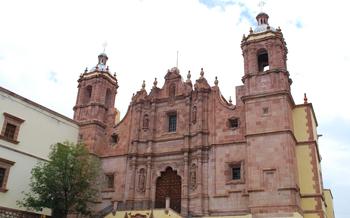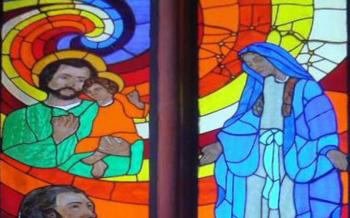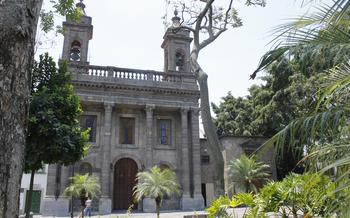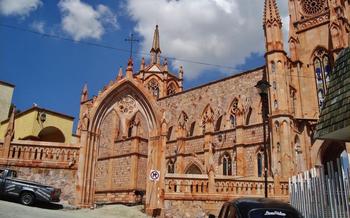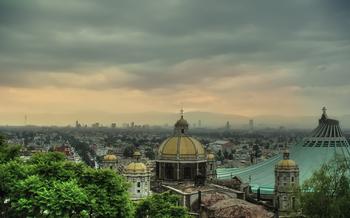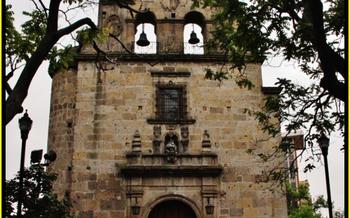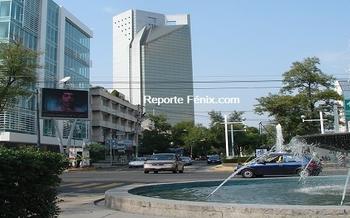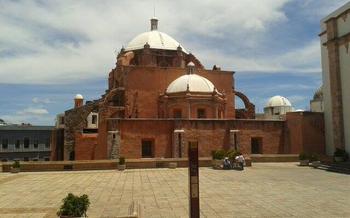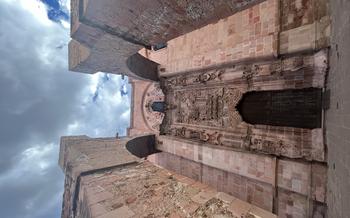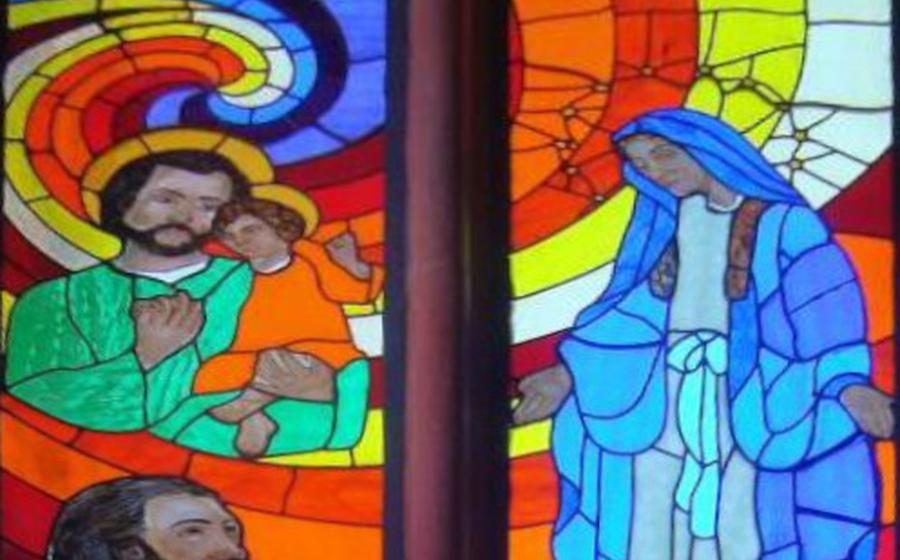
Templo de Fatima
- The Sanctuary's History: A Tale of Faith and Miracles
- Architectural Splendor: A Masterpiece of Neo-Gothic Design
- Exploring the Interior: A Journey through Art and Faith.
- A Pilgrimage Site: Devotees from Near and Far
- The Healing Waters: A Source of Miracles and Hope
- A Symbol of Hope in Turbulent Times: The Temple During the Revolution
- The Virgin of Fatima: A Beacon of Faith and Devotion
- Cultural Heritage and Local Traditions: The Temple's Impact on Zacatecas
- A Place of Reflection and Serenity: The Temple's Spiritual Significance
- The Templo de Fatima Museum: Unveiling the Sanctuary's History
- Festivals and Celebrations: Honoring the Virgin of Fatima
- Accessibility and Transportation: Planning Your Visit
- Accommodation and Dining: Options Near the Templo de Fatima
- Insider Tip: Exploring the Hidden Gem of the Temple's Gardens
The Sanctuary's History: A Tale of Faith and Miracles
The devotion to Our Lady of Fatima in Mexico has its roots in the early 20th century when Portuguese immigrants, fleeing religious persecution in their homeland, brought with them their deep faith in the Virgin Mary. In Zacatecas, these immigrants played a crucial role in the construction of the Templo de Fatima, contributing their skills, resources, and unwavering devotion.
The sanctuary is steeped in tales of miraculous events and healings, further solidifying its reputation as a sacred site. Devotees recount stories of miraculous cures, answered prayers, and divine interventions that have occurred within the temple walls. These miraculous occurrences have strengthened the faith of believers and attracted pilgrims from far and wide, seeking solace, healing, and spiritual renewal.
Local legends and stories surrounding the temple add to its mystique. One such legend tells of a young woman who was miraculously healed from a terminal illness after praying at the sanctuary. In gratitude, she donated her beautiful hair to the Virgin, which was then used to create a magnificent wig that adorned the statue of Our Lady of Fatima. This legend has been passed down through generations, symbolizing the transformative power of faith and the enduring legacy of the Templo de Fatima.
Architectural Splendor: A Masterpiece of Neo-Gothic Design
The Templo de Fatima stands as a testament to the architectural prowess of its creators. Its unique design blends elements of Neo-Gothic and Romanesque styles, resulting in a majestic structure that is both awe-inspiring and serene. The pointed arches, ribbed vaults, and flying buttresses are reminiscent of medieval cathedrals, while the intricate carvings and decorative details add a touch of Baroque opulence.
The use of local materials such as cantera stone and Zacatecan wood adds a sense of authenticity and regional character to the temple. The facade features elaborate sculptures depicting biblical scenes and religious figures, while the interior is adorned with stunning stained-glass windows that cast a kaleidoscope of colors onto the marble floors.
The construction of the Templo de Fatima was a collaborative effort involving skilled engineers and architects who worked tirelessly to bring the vision of a grand sanctuary to life. Their dedication and craftsmanship are evident in every detail of this architectural masterpiece, which has become a symbol of faith and devotion in Zacatecas.
Exploring the Interior: A Journey through Art and Faith.
Venturing inside the Templo de Fatima is like embarking on a journey through sacred art and unwavering faith. The intricate stained glass windows, meticulously crafted by skilled artisans, depict biblical scenes with vibrant colors and lifelike details, casting a warm, celestial glow upon the interior space. The walls and ceilings are adorned with impressive murals and frescoes, narrating stories from the Bible and showcasing the lives of saints, each stroke infused with devotion and artistic mastery. Exquisitely carved statues and religious artifacts, meticulously positioned throughout the sanctuary, invite visitors to pause and contemplate the profound symbolism and iconography they embody. Every element, from the intricately designed altars to the delicate tapestries, contributes to the temple's aura of spirituality and reverence, making it a place where art and faith harmoniously converge.
A Pilgrimage Site: Devotees from Near and Far
The Templo de Fatima holds special significance as a pilgrimage destination for devotees of Our Lady of Fatima from across Mexico and beyond. Each year, thousands of pilgrims flock to the sanctuary to pay homage to the Virgin and seek her blessings. The annual festivities and religious events held at the temple attract a diverse crowd of believers, creating a vibrant and spiritual atmosphere.
During the pilgrimage season, the temple buzzes with activity as pilgrims participate in a variety of traditions and rituals. These include attending special masses, praying the rosary, and lighting candles in honor of the Virgin. Many pilgrims also undertake the traditional walk from the city center to the sanctuary, as a symbolic act of devotion and penance.
The experiences and stories of pilgrims who have visited the temple are diverse and deeply personal. Some have reported witnessing miracles or receiving divine healing, while others have found solace and comfort within the sanctuary's sacred walls. The Templo de Fatima serves as a beacon of hope and spiritual renewal for countless individuals, who come seeking guidance, strength, and a deeper connection with their faith.
The Healing Waters: A Source of Miracles and Hope
The Templo de Fatima is renowned not only for its architectural splendor but also for the legendary healing powers associated with the water from its well. Pilgrims and visitors alike have shared remarkable stories of miraculous healings and answered prayers after drinking or bathing in the water. The well, located within the sanctuary grounds, has become a symbol of hope and divine intervention for those seeking solace and relief from ailments.
The healing properties of the water have been attributed to its unique mineral composition and the blessings bestowed upon it by the Virgin of Fatima. Devotees believe that the water possesses the power to cure physical illnesses, emotional wounds, and spiritual afflictions. Testimonies of miraculous healings abound, ranging from the restoration of sight to the healing of chronic diseases.
Beyond its religious significance, the healing waters also hold scientific and spiritual explanations. The water's mineral content, including calcium, magnesium, and bicarbonates, is believed to have therapeutic effects on the human body. Additionally, the serene and spiritual atmosphere of the sanctuary is said to promote relaxation and healing, enhancing the body's natural ability to repair itself.
Whether attributed to divine intervention, scientific properties, or a combination of both, the healing waters of the Templo de Fatima continue to attract countless pilgrims and visitors seeking solace, hope, and renewal. The well serves as a testament to the enduring power of faith and the belief in the miraculous.
A Symbol of Hope in Turbulent Times: The Temple During the Revolution
Amidst the chaos and bloodshed of the Mexican Revolution, the Templo de Fatima stood as a beacon of hope and refuge for the people of Zacatecas. As the fighting raged on, the temple became a sanctuary for those seeking solace, protection, and spiritual guidance.
Stories abound of the temple's role during this tumultuous period. One tale tells of a group of villagers who sought shelter within the church walls as a fierce battle raged outside. Despite the danger, the villagers found comfort and strength in their faith, praying together and seeking divine protection.
Another story speaks of a young woman who was desperately searching for her missing husband, a soldier who had been fighting in the revolution. She came to the Templo de Fatima and prayed fervently for his safety. Miraculously, her prayers were answered, and her husband returned home to her, safe and sound.
The temple itself miraculously remained untouched by the violence that engulfed the city, a testament to its sacred status and the enduring power of faith. It served as a place of healing, both physical and spiritual, for those affected by the conflict.
Even during the darkest days of the revolution, the Templo de Fatima remained a symbol of hope and resilience for the people of Zacatecas. Its legacy as a sanctuary during this turbulent time continues to inspire and uplift those who visit its hallowed halls today.
The Virgin of Fatima: A Beacon of Faith and Devotion
The Templo de Fatima is dedicated to Our Lady of Fatima, a venerated figure in the Catholic Church. The origins of the devotion to the Virgin of Fatima can be traced back to the apparitions of the Virgin Mary to three shepherd children in the village of Fatima, Portugal, in 191During these apparitions, the Virgin Mary conveyed messages of peace, repentance, and the need for prayer. The apparitions gained worldwide attention and led to the construction of several sanctuaries in honor of the Virgin of Fatima, including the Templo de Fatima in Zacatecas.
The Virgin of Fatima holds a special place in the hearts of Mexican Catholics, who have a deep devotion to the Virgin Mary. In Mexico, the Virgin of Fatima is seen as a symbol of hope, protection, and divine intervention. Many pilgrims visit the Templo de Fatima to pray to the Virgin Mary, seeking her intercession and guidance in their lives. The feast day of Our Lady of Fatima, celebrated on May 13, is a major religious event in Zacatecas, attracting thousands of pilgrims from across the region.
Cultural Heritage and Local Traditions: The Temple's Impact on Zacatecas
The Templo de Fatima has played a pivotal role in shaping the cultural identity of Zacatecas. It stands as a testament to the city's rich religious heritage and the deep devotion of its people. The sanctuary has become an integral part of the local traditions and customs, fostering a sense of community and unity among the residents.
The temple's influence extends beyond its religious significance. It has become a symbol of Zacatecas's cultural heritage, attracting tourists from around the world. The unique blend of architectural styles and the intricate artwork within the sanctuary showcase the city's artistic prowess and craftsmanship.
The Templo de Fatima has contributed significantly to Zacatecas's historical and cultural tourism. Pilgrims and visitors from various backgrounds flock to the city to witness the architectural grandeur and experience the spiritual ambiance of the sanctuary. The temple's presence has helped to promote Zacatecas as a pilgrimage destination, attracting both domestic and international travelers.
Through its enduring legacy, the Templo de Fatima continues to serve as a beacon of faith and devotion while simultaneously enriching the cultural tapestry of Zacatecas.
A Place of Reflection and Serenity: The Temple's Spiritual Significance
Amidst the bustling city of Zacatecas, the Templo de Fatima stands as an oasis of peace and tranquility. Its sacred interiors invite visitors to embark on a journey of spiritual renewal and self-reflection. The atmosphere within the sanctuary is palpable, enveloping the senses with a sense of serenity and calm. Whether seeking solace, guidance, or a deeper connection with the divine, the temple provides a sacred space for prayer, meditation, and contemplation. Pilgrims and visitors alike are drawn to the temple's tranquil ambiance, finding respite from the world's distractions and an opportunity to reconnect with their inner selves. Personal stories abound of individuals who have experienced profound spiritual encounters and transformations within the temple's hallowed walls, making it a place of profound spiritual significance.
The Templo de Fatima Museum: Unveiling the Sanctuary's History
Nestled within the grounds of the Templo de Fatima, the museum serves as a repository of the sanctuary's rich history and cultural significance. Established to educate and inform visitors, the museum houses a collection of artifacts, documents, and photographs that chronicle the temple's journey from its inception to the present day.
Exhibits within the museum showcase the architectural design and construction of the Templo de Fatima, highlighting the unique features and influences that shaped its Neo-Gothic style. Visitors can learn about the contributions of Portuguese immigrants to the temple's construction and the role of local artisans and craftsmen in bringing the sanctuary to life.
The museum also delves into the religious significance of the Templo de Fatima, exploring the origins of the devotion to Our Lady of Fatima in Mexico and the miraculous events associated with the sanctuary. Visitors can view relics and personal items related to the Virgin of Fatima, as well as learn about the healing powers attributed to the water from the sanctuary's well.
Through interactive displays and multimedia presentations, the museum brings the history of the Templo de Fatima to life, offering visitors a deeper understanding of the sanctuary's spiritual and cultural importance. It serves as a valuable resource for pilgrims, history buffs, and anyone interested in exploring the rich heritage of Zacatecas.
Festivals and Celebrations: Honoring the Virgin of Fatima
The annual feast day of Our Lady of Fatima, celebrated on May 13th, is the grandest and most significant event at the Templo de Fatima. The sanctuary comes alive with a vibrant atmosphere as thousands of devotees and pilgrims gather to honor the Virgin Mary.
The day begins with a solemn mass followed by a grand procession, where the statue of Our Lady of Fatima is carried through the streets of Zacatecas, accompanied by music, prayers, and the faithful. Local communities and organizations participate in the procession, adding to the festive spirit.
Throughout the day, there are various cultural performances, concerts, and religious events held at the sanctuary. Traditional dances, music, and theatrical reenactments of the apparitions of Fatima entertain and engage the visitors.
The feast day celebrations are not just a display of religious devotion but also a celebration of Zacatecas's cultural heritage. The Templo de Fatima becomes a focal point of unity, bringing together people from all walks of life to honor the Virgin Mary and celebrate their shared faith.
Accessibility and Transportation: Planning Your Visit
The Templo de Fatima is conveniently located in the heart of Zacatecas, making it easily accessible for visitors. To reach the sanctuary, you can take a leisurely stroll from the city center, which takes approximately 15-20 minutes. Alternatively, you can opt for public transportation, with several bus routes passing nearby. The "Templo de Fatima" stop is a convenient option, allowing you to disembark right outside the sanctuary's gates. For those arriving by car, there is ample parking space available in the vicinity of the temple. Visitors with disabilities will find the sanctuary fully accessible, with wheelchair ramps, elevators, and designated parking spaces ensuring a comfortable and hassle-free visit. To make the most of your visit, plan your trip during the cooler months (October to April) to avoid the intense summer heat. Remember to dress respectfully, covering your shoulders and knees when entering the sanctuary.
Accommodation and Dining: Options Near the Templo de Fatima
Finding suitable accommodation and delicious dining options near the Templo de Fatima is crucial for a comfortable and fulfilling visit. Fortunately, the area boasts a range of hotels and restaurants catering to diverse needs and budgets.
Within walking distance of the sanctuary, you'll find several charming hotels that offer a range of amenities and price points. Whether you prefer cozy bed and breakfasts or modern chain hotels, there's something to suit every taste.
For your dining needs, the surrounding area offers a tantalizing array of restaurants and cafes. Indulge in the flavors of traditional Zacatecan cuisine at local eateries, or savor international dishes at renowned restaurants. Whether you're craving hearty stews, mouthwatering enchiladas, or delectable desserts, you'll find something to satisfy your palate.
For budget-conscious travelers, there are several affordable options that offer simple yet comfortable accommodations. For those seeking a more luxurious experience, upscale hotels provide elegant rooms, impeccable service, and breathtaking views of the city.
To truly immerse yourself in the local culture, venture beyond the main tourist areas and seek out hidden gems that serve authentic Zacatecan dishes. Ask locals for recommendations or explore side streets to discover culinary treasures that will leave you craving more.
With careful planning, you can easily find accommodation and dining options that complement your visit to the Templo de Fatima, ensuring a memorable and enjoyable experience.
Insider Tip: Exploring the Hidden Gem of the Temple's Gardens
Beyond the grandeur of the Templo de Fatima's architecture, visitors can find solace and tranquility in its enchanting gardens. Nestled amidst the bustling city, these serene green spaces offer a haven for contemplation and spiritual reflection. Stroll along the winding paths, surrounded by vibrant flowers and lush greenery, each carefully chosen to symbolize aspects of faith and devotion.
At the heart of the gardens lies a hidden gem – a grotto dedicated to the Virgin of Fatima. This secluded sanctuary invites visitors to pause and connect with the divine. The soft glow of candles illuminates the serene figure of Our Lady, creating an atmosphere of peace and reverence. Whether seeking a moment of quiet reflection or a deeper spiritual connection, the temple's gardens provide a sanctuary for the soul.
